CPCCBC4012B Read Plans & Specs - Project 1 Solution Open Colleges
VerifiedAdded on 2023/06/03
|18
|2056
|224
Practical Assignment
AI Summary
This assignment solution pertains to the CPCCBC4012B unit, focusing on reading and interpreting plans and specifications within the context of a construction project. The scenario involves clients, David and Tara King, who require a double garage with a workshop on their property. The solution includes completing tables detailing different types of drawings (architectural, structural, mechanical) and their purposes, along with explanations of drawing aspects like elevations, plans, and sections. It also involves creating freehand drawings, including a site plan with the garage/workshop footprint, an updated site plan with a residential building footprint, and orthographic drawings of the garage/workshop, adhering to specific scales and international conventions. Furthermore, the solution provides a written explanation differentiating between provisional sum and prime cost, and a site features table listing key site features with corresponding Building Code of Australia (BCA) requirements and necessary approvals. The assignment emphasizes practical application and understanding of construction documentation and regulations.
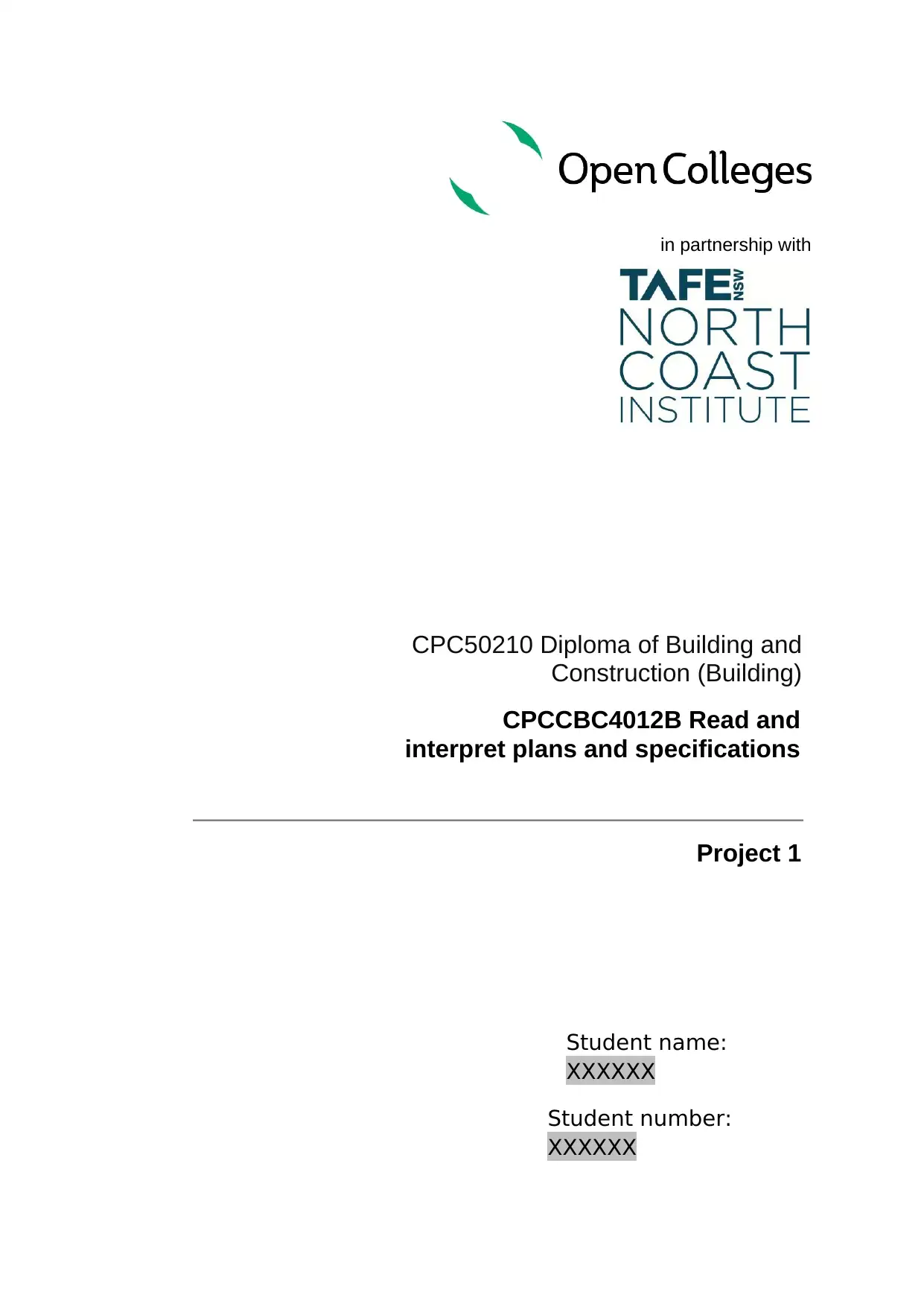
in partnership with
CPC50210 Diploma of Building and
Construction (Building)
CPCCBC4012B Read and
interpret plans and specifications
Project 1
Student name:
XXXXXX
Student number:
XXXXXX
CPC50210 Diploma of Building and
Construction (Building)
CPCCBC4012B Read and
interpret plans and specifications
Project 1
Student name:
XXXXXX
Student number:
XXXXXX
Paraphrase This Document
Need a fresh take? Get an instant paraphrase of this document with our AI Paraphraser

Assessment: 32634/01
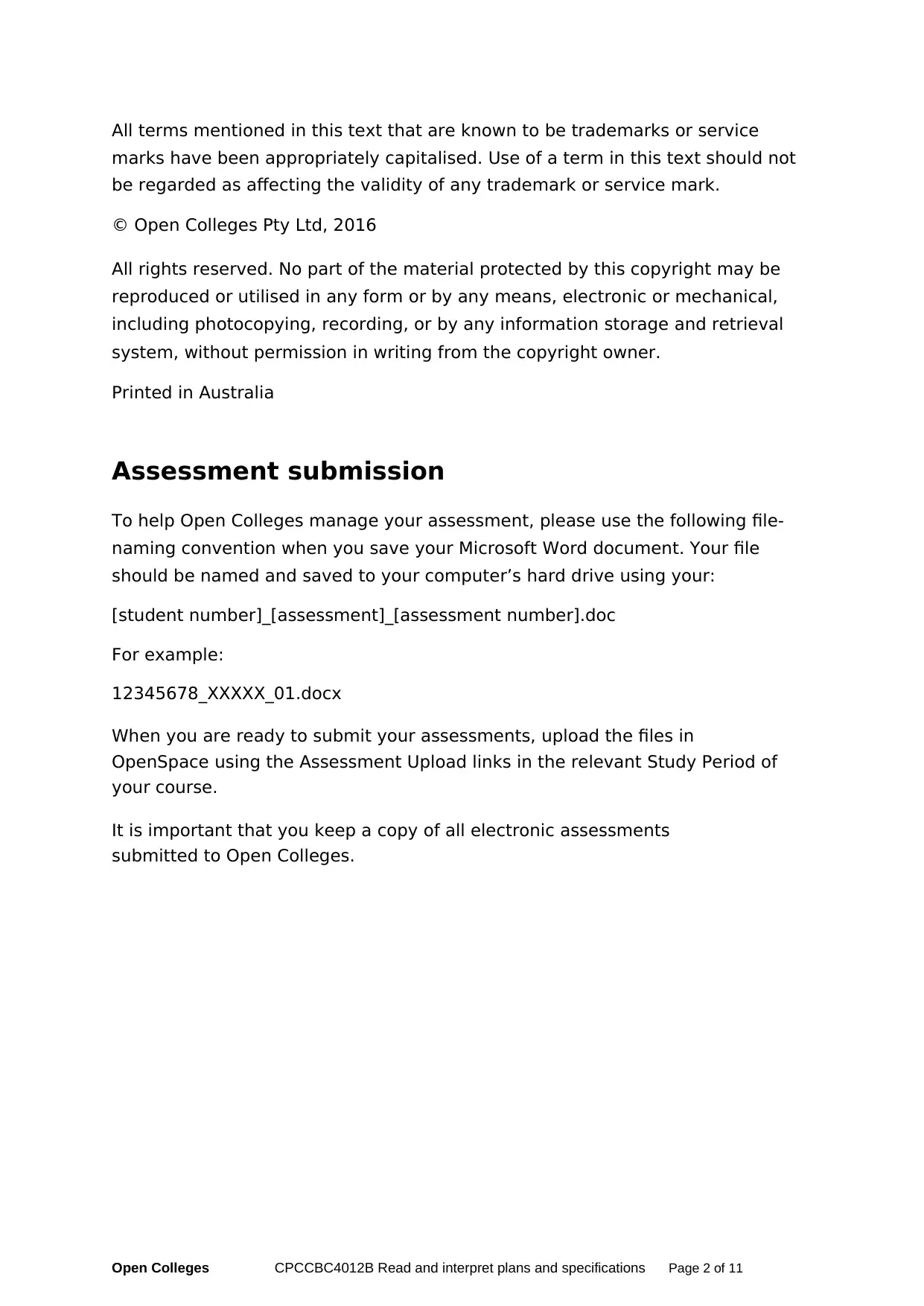
All terms mentioned in this text that are known to be trademarks or service
marks have been appropriately capitalised. Use of a term in this text should not
be regarded as affecting the validity of any trademark or service mark.
© Open Colleges Pty Ltd, 2016
All rights reserved. No part of the material protected by this copyright may be
reproduced or utilised in any form or by any means, electronic or mechanical,
including photocopying, recording, or by any information storage and retrieval
system, without permission in writing from the copyright owner.
Printed in Australia
Assessment submission
To help Open Colleges manage your assessment, please use the following file-
naming convention when you save your Microsoft Word document. Your file
should be named and saved to your computer’s hard drive using your:
[student number]_[assessment]_[assessment number].doc
For example:
12345678_XXXXX_01.docx
When you are ready to submit your assessments, upload the files in
OpenSpace using the Assessment Upload links in the relevant Study Period of
your course.
It is important that you keep a copy of all electronic assessments
submitted to Open Colleges.
Open Colleges CPCCBC4012B Read and interpret plans and specifications Page 2 of 11
marks have been appropriately capitalised. Use of a term in this text should not
be regarded as affecting the validity of any trademark or service mark.
© Open Colleges Pty Ltd, 2016
All rights reserved. No part of the material protected by this copyright may be
reproduced or utilised in any form or by any means, electronic or mechanical,
including photocopying, recording, or by any information storage and retrieval
system, without permission in writing from the copyright owner.
Printed in Australia
Assessment submission
To help Open Colleges manage your assessment, please use the following file-
naming convention when you save your Microsoft Word document. Your file
should be named and saved to your computer’s hard drive using your:
[student number]_[assessment]_[assessment number].doc
For example:
12345678_XXXXX_01.docx
When you are ready to submit your assessments, upload the files in
OpenSpace using the Assessment Upload links in the relevant Study Period of
your course.
It is important that you keep a copy of all electronic assessments
submitted to Open Colleges.
Open Colleges CPCCBC4012B Read and interpret plans and specifications Page 2 of 11
⊘ This is a preview!⊘
Do you want full access?
Subscribe today to unlock all pages.

Trusted by 1+ million students worldwide
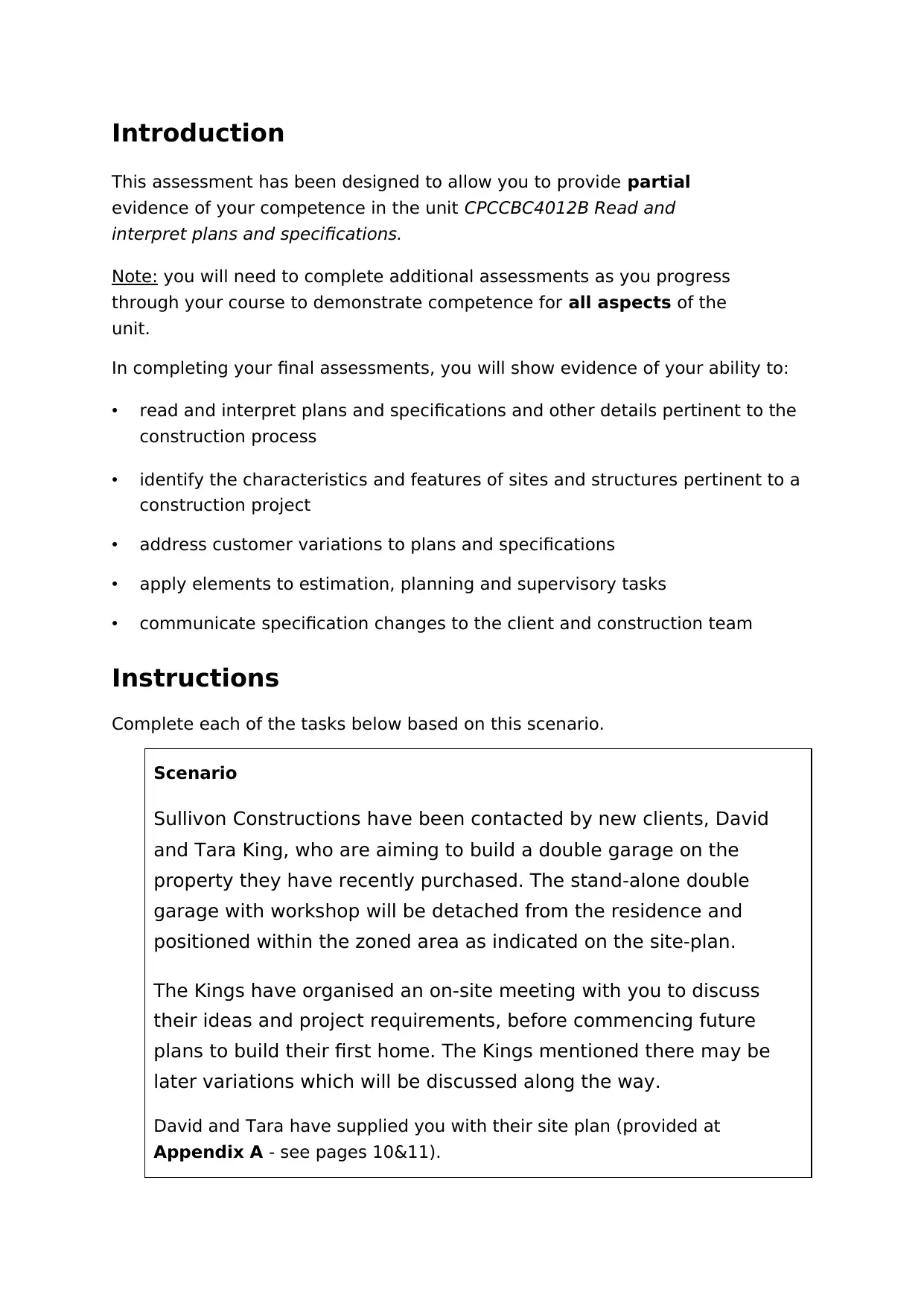
Introduction
This assessment has been designed to allow you to provide partial
evidence of your competence in the unit CPCCBC4012B Read and
interpret plans and specifications.
Note: you will need to complete additional assessments as you progress
through your course to demonstrate competence for all aspects of the
unit.
In completing your final assessments, you will show evidence of your ability to:
• read and interpret plans and specifications and other details pertinent to the
construction process
• identify the characteristics and features of sites and structures pertinent to a
construction project
• address customer variations to plans and specifications
• apply elements to estimation, planning and supervisory tasks
• communicate specification changes to the client and construction team
Instructions
Complete each of the tasks below based on this scenario.
Scenario
Sullivon Constructions have been contacted by new clients, David
and Tara King, who are aiming to build a double garage on the
property they have recently purchased. The stand-alone double
garage with workshop will be detached from the residence and
positioned within the zoned area as indicated on the site-plan.
The Kings have organised an on-site meeting with you to discuss
their ideas and project requirements, before commencing future
plans to build their first home. The Kings mentioned there may be
later variations which will be discussed along the way.
David and Tara have supplied you with their site plan (provided at
Appendix A - see pages 10&11).
This assessment has been designed to allow you to provide partial
evidence of your competence in the unit CPCCBC4012B Read and
interpret plans and specifications.
Note: you will need to complete additional assessments as you progress
through your course to demonstrate competence for all aspects of the
unit.
In completing your final assessments, you will show evidence of your ability to:
• read and interpret plans and specifications and other details pertinent to the
construction process
• identify the characteristics and features of sites and structures pertinent to a
construction project
• address customer variations to plans and specifications
• apply elements to estimation, planning and supervisory tasks
• communicate specification changes to the client and construction team
Instructions
Complete each of the tasks below based on this scenario.
Scenario
Sullivon Constructions have been contacted by new clients, David
and Tara King, who are aiming to build a double garage on the
property they have recently purchased. The stand-alone double
garage with workshop will be detached from the residence and
positioned within the zoned area as indicated on the site-plan.
The Kings have organised an on-site meeting with you to discuss
their ideas and project requirements, before commencing future
plans to build their first home. The Kings mentioned there may be
later variations which will be discussed along the way.
David and Tara have supplied you with their site plan (provided at
Appendix A - see pages 10&11).
Paraphrase This Document
Need a fresh take? Get an instant paraphrase of this document with our AI Paraphraser

Open Colleges CPCCBC4012B Read and interpret plans and specifications Page 3 of 11
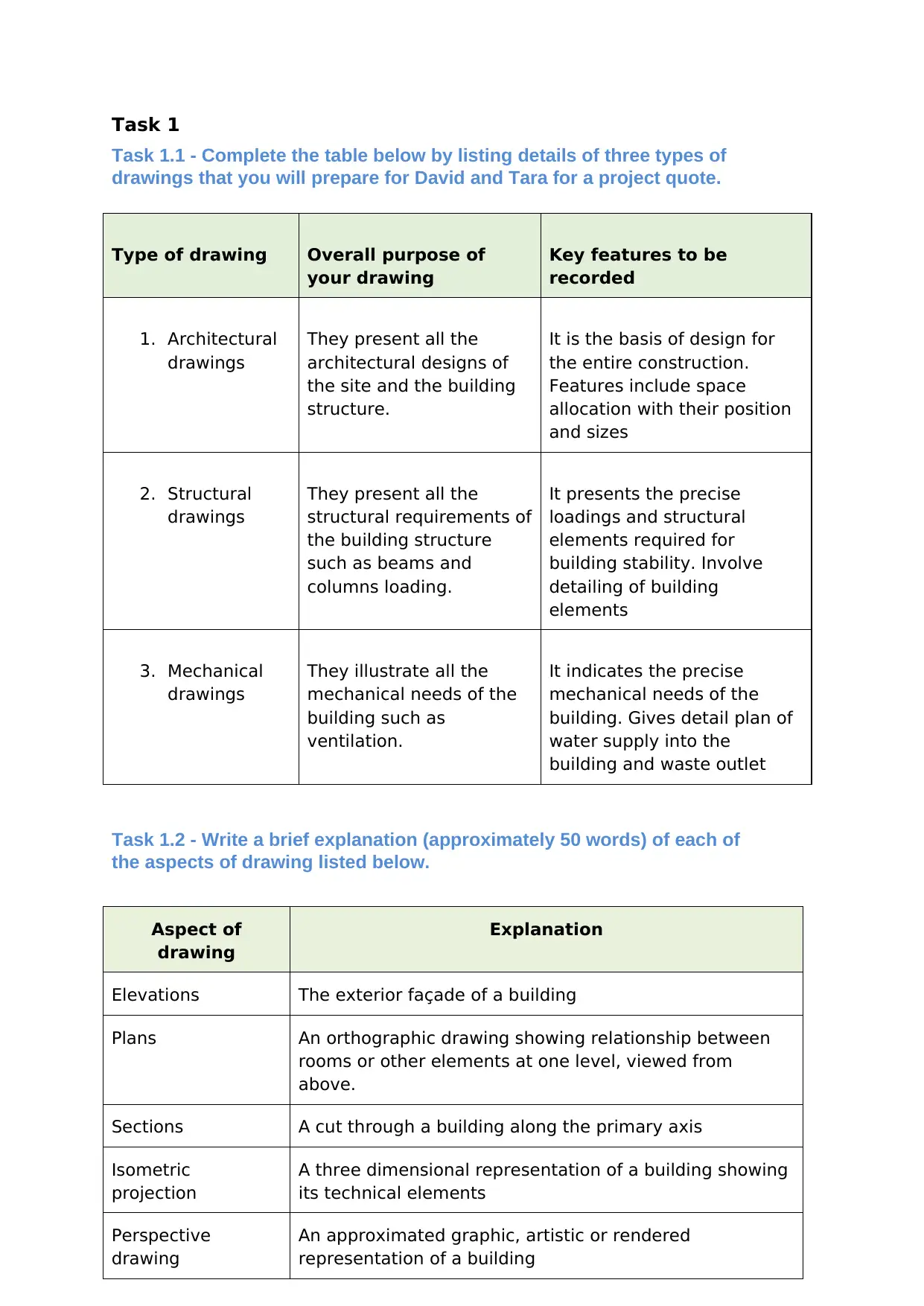
Task 1
Task 1.1 - Complete the table below by listing details of three types of
drawings that you will prepare for David and Tara for a project quote.
Type of drawing Overall purpose of
your drawing
Key features to be
recorded
1. Architectural
drawings
They present all the
architectural designs of
the site and the building
structure.
It is the basis of design for
the entire construction.
Features include space
allocation with their position
and sizes
2. Structural
drawings
They present all the
structural requirements of
the building structure
such as beams and
columns loading.
It presents the precise
loadings and structural
elements required for
building stability. Involve
detailing of building
elements
3. Mechanical
drawings
They illustrate all the
mechanical needs of the
building such as
ventilation.
It indicates the precise
mechanical needs of the
building. Gives detail plan of
water supply into the
building and waste outlet
Task 1.2 - Write a brief explanation (approximately 50 words) of each of
the aspects of drawing listed below.
Aspect of
drawing
Explanation
Elevations The exterior façade of a building
Plans An orthographic drawing showing relationship between
rooms or other elements at one level, viewed from
above.
Sections A cut through a building along the primary axis
Isometric
projection
A three dimensional representation of a building showing
its technical elements
Perspective
drawing
An approximated graphic, artistic or rendered
representation of a building
Task 1.1 - Complete the table below by listing details of three types of
drawings that you will prepare for David and Tara for a project quote.
Type of drawing Overall purpose of
your drawing
Key features to be
recorded
1. Architectural
drawings
They present all the
architectural designs of
the site and the building
structure.
It is the basis of design for
the entire construction.
Features include space
allocation with their position
and sizes
2. Structural
drawings
They present all the
structural requirements of
the building structure
such as beams and
columns loading.
It presents the precise
loadings and structural
elements required for
building stability. Involve
detailing of building
elements
3. Mechanical
drawings
They illustrate all the
mechanical needs of the
building such as
ventilation.
It indicates the precise
mechanical needs of the
building. Gives detail plan of
water supply into the
building and waste outlet
Task 1.2 - Write a brief explanation (approximately 50 words) of each of
the aspects of drawing listed below.
Aspect of
drawing
Explanation
Elevations The exterior façade of a building
Plans An orthographic drawing showing relationship between
rooms or other elements at one level, viewed from
above.
Sections A cut through a building along the primary axis
Isometric
projection
A three dimensional representation of a building showing
its technical elements
Perspective
drawing
An approximated graphic, artistic or rendered
representation of a building
⊘ This is a preview!⊘
Do you want full access?
Subscribe today to unlock all pages.

Trusted by 1+ million students worldwide
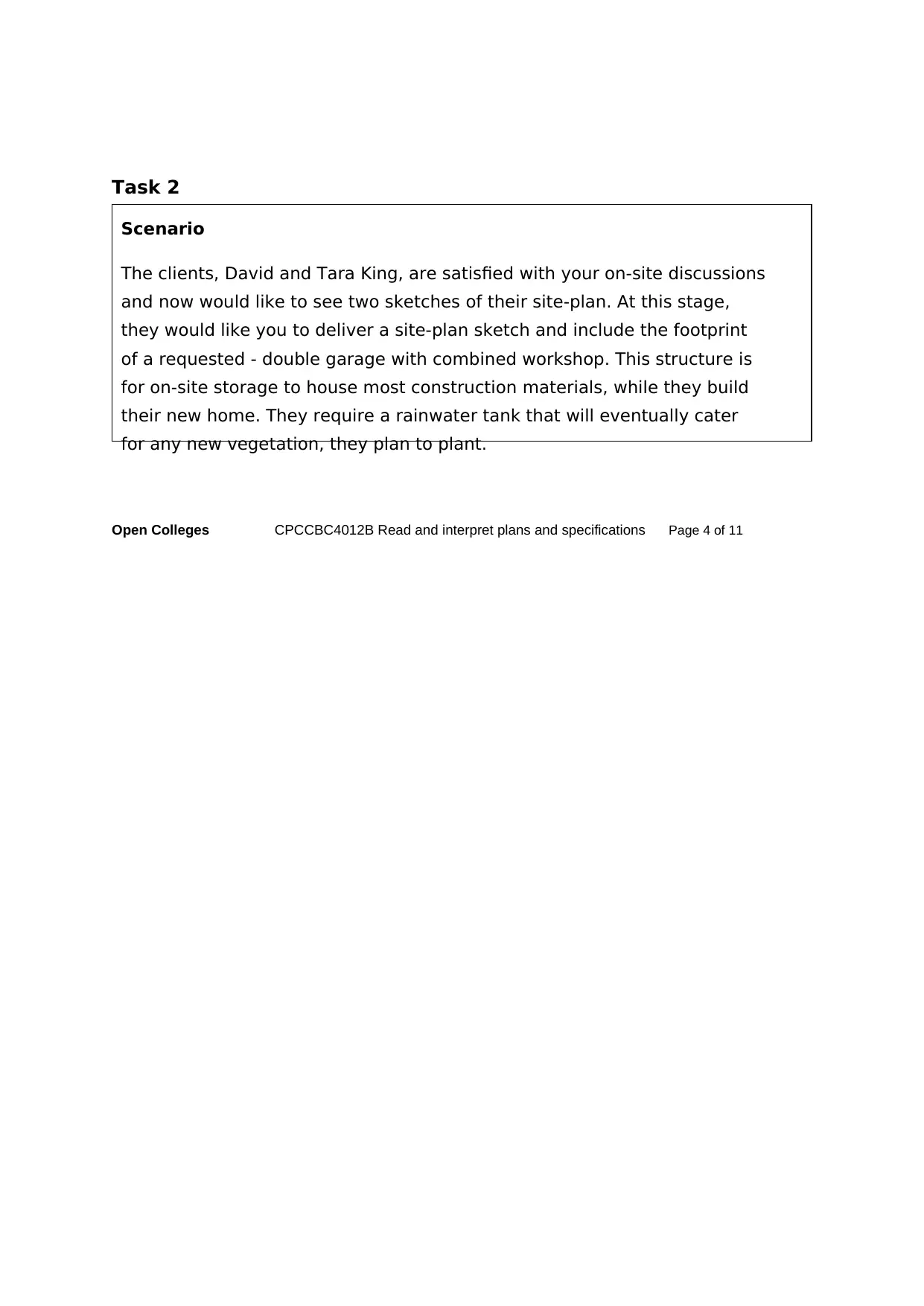
Task 2
Scenario
The clients, David and Tara King, are satisfied with your on-site discussions
and now would like to see two sketches of their site-plan. At this stage,
they would like you to deliver a site-plan sketch and include the footprint
of a requested - double garage with combined workshop. This structure is
for on-site storage to house most construction materials, while they build
their new home. They require a rainwater tank that will eventually cater
for any new vegetation, they plan to plant.
Open Colleges CPCCBC4012B Read and interpret plans and specifications Page 4 of 11
Scenario
The clients, David and Tara King, are satisfied with your on-site discussions
and now would like to see two sketches of their site-plan. At this stage,
they would like you to deliver a site-plan sketch and include the footprint
of a requested - double garage with combined workshop. This structure is
for on-site storage to house most construction materials, while they build
their new home. They require a rainwater tank that will eventually cater
for any new vegetation, they plan to plant.
Open Colleges CPCCBC4012B Read and interpret plans and specifications Page 4 of 11
Paraphrase This Document
Need a fresh take? Get an instant paraphrase of this document with our AI Paraphraser
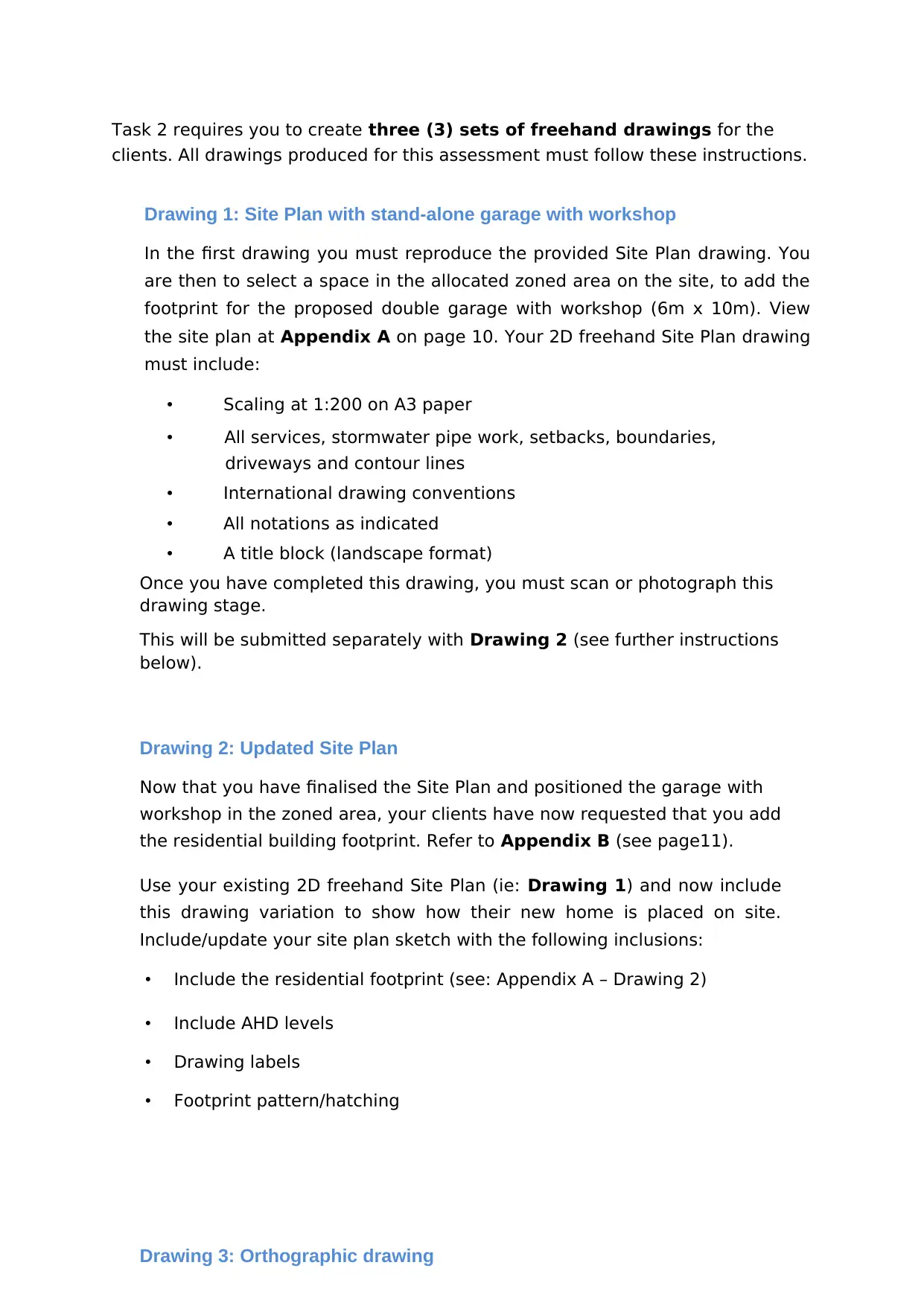
Task 2 requires you to create three (3) sets of freehand drawings for the
clients. All drawings produced for this assessment must follow these instructions.
Drawing 1: Site Plan with stand-alone garage with workshop
In the first drawing you must reproduce the provided Site Plan drawing. You
are then to select a space in the allocated zoned area on the site, to add the
footprint for the proposed double garage with workshop (6m x 10m). View
the site plan at Appendix A on page 10. Your 2D freehand Site Plan drawing
must include:
• Scaling at 1:200 on A3 paper
• All services, stormwater pipe work, setbacks, boundaries,
driveways and contour lines
• International drawing conventions
• All notations as indicated
• A title block (landscape format)
Once you have completed this drawing, you must scan or photograph this
drawing stage.
This will be submitted separately with Drawing 2 (see further instructions
below).
Drawing 2: Updated Site Plan
Now that you have finalised the Site Plan and positioned the garage with
workshop in the zoned area, your clients have now requested that you add
the residential building footprint. Refer to Appendix B (see page11).
Use your existing 2D freehand Site Plan (ie: Drawing 1) and now include
this drawing variation to show how their new home is placed on site.
Include/update your site plan sketch with the following inclusions:
• Include the residential footprint (see: Appendix A – Drawing 2)
• Include AHD levels
• Drawing labels
• Footprint pattern/hatching
Drawing 3: Orthographic drawing
clients. All drawings produced for this assessment must follow these instructions.
Drawing 1: Site Plan with stand-alone garage with workshop
In the first drawing you must reproduce the provided Site Plan drawing. You
are then to select a space in the allocated zoned area on the site, to add the
footprint for the proposed double garage with workshop (6m x 10m). View
the site plan at Appendix A on page 10. Your 2D freehand Site Plan drawing
must include:
• Scaling at 1:200 on A3 paper
• All services, stormwater pipe work, setbacks, boundaries,
driveways and contour lines
• International drawing conventions
• All notations as indicated
• A title block (landscape format)
Once you have completed this drawing, you must scan or photograph this
drawing stage.
This will be submitted separately with Drawing 2 (see further instructions
below).
Drawing 2: Updated Site Plan
Now that you have finalised the Site Plan and positioned the garage with
workshop in the zoned area, your clients have now requested that you add
the residential building footprint. Refer to Appendix B (see page11).
Use your existing 2D freehand Site Plan (ie: Drawing 1) and now include
this drawing variation to show how their new home is placed on site.
Include/update your site plan sketch with the following inclusions:
• Include the residential footprint (see: Appendix A – Drawing 2)
• Include AHD levels
• Drawing labels
• Footprint pattern/hatching
Drawing 3: Orthographic drawing

Open Colleges CPCCBC4012B Read and interpret plans and specifications Page 5 of 11
⊘ This is a preview!⊘
Do you want full access?
Subscribe today to unlock all pages.

Trusted by 1+ million students worldwide
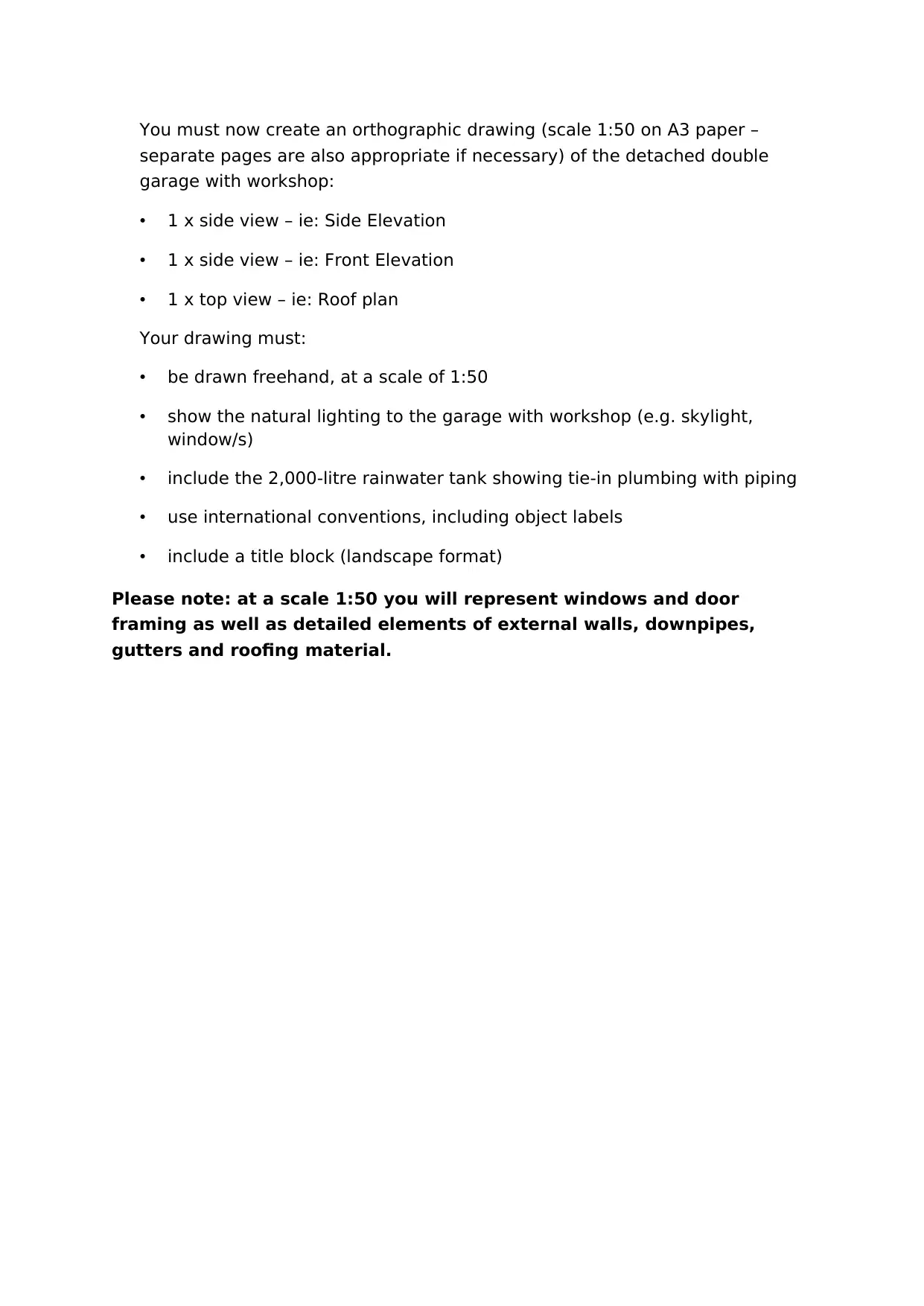
You must now create an orthographic drawing (scale 1:50 on A3 paper –
separate pages are also appropriate if necessary) of the detached double
garage with workshop:
• 1 x side view – ie: Side Elevation
• 1 x side view – ie: Front Elevation
• 1 x top view – ie: Roof plan
Your drawing must:
• be drawn freehand, at a scale of 1:50
• show the natural lighting to the garage with workshop (e.g. skylight,
window/s)
• include the 2,000-litre rainwater tank showing tie-in plumbing with piping
• use international conventions, including object labels
• include a title block (landscape format)
Please note: at a scale 1:50 you will represent windows and door
framing as well as detailed elements of external walls, downpipes,
gutters and roofing material.
separate pages are also appropriate if necessary) of the detached double
garage with workshop:
• 1 x side view – ie: Side Elevation
• 1 x side view – ie: Front Elevation
• 1 x top view – ie: Roof plan
Your drawing must:
• be drawn freehand, at a scale of 1:50
• show the natural lighting to the garage with workshop (e.g. skylight,
window/s)
• include the 2,000-litre rainwater tank showing tie-in plumbing with piping
• use international conventions, including object labels
• include a title block (landscape format)
Please note: at a scale 1:50 you will represent windows and door
framing as well as detailed elements of external walls, downpipes,
gutters and roofing material.
Paraphrase This Document
Need a fresh take? Get an instant paraphrase of this document with our AI Paraphraser

Open Colleges CPCCBC4012B Read and interpret plans and specifications Page 6 of 11
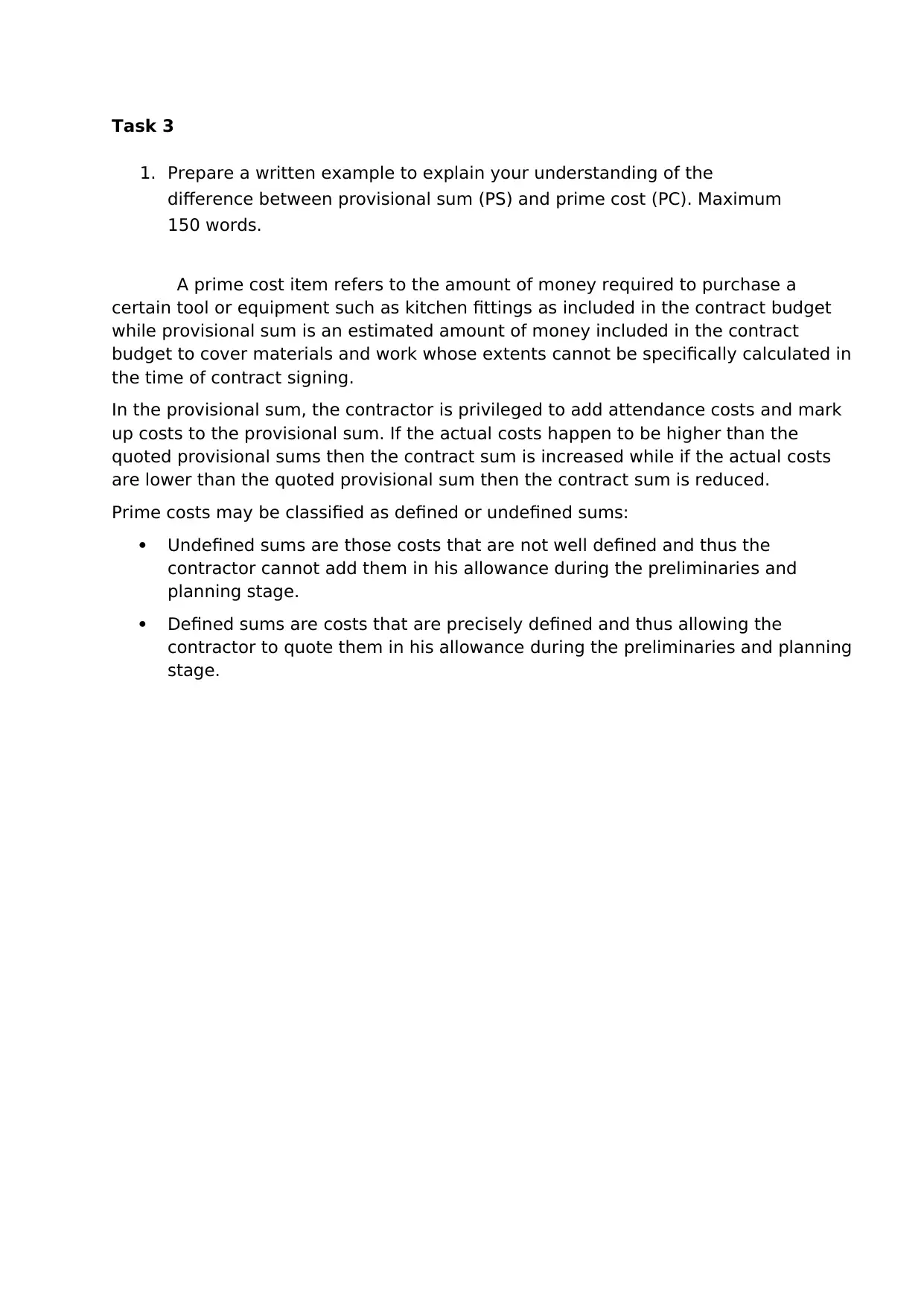
Task 3
1. Prepare a written example to explain your understanding of the
difference between provisional sum (PS) and prime cost (PC). Maximum
150 words.
A prime cost item refers to the amount of money required to purchase a
certain tool or equipment such as kitchen fittings as included in the contract budget
while provisional sum is an estimated amount of money included in the contract
budget to cover materials and work whose extents cannot be specifically calculated in
the time of contract signing.
In the provisional sum, the contractor is privileged to add attendance costs and mark
up costs to the provisional sum. If the actual costs happen to be higher than the
quoted provisional sums then the contract sum is increased while if the actual costs
are lower than the quoted provisional sum then the contract sum is reduced.
Prime costs may be classified as defined or undefined sums:
Undefined sums are those costs that are not well defined and thus the
contractor cannot add them in his allowance during the preliminaries and
planning stage.
Defined sums are costs that are precisely defined and thus allowing the
contractor to quote them in his allowance during the preliminaries and planning
stage.
1. Prepare a written example to explain your understanding of the
difference between provisional sum (PS) and prime cost (PC). Maximum
150 words.
A prime cost item refers to the amount of money required to purchase a
certain tool or equipment such as kitchen fittings as included in the contract budget
while provisional sum is an estimated amount of money included in the contract
budget to cover materials and work whose extents cannot be specifically calculated in
the time of contract signing.
In the provisional sum, the contractor is privileged to add attendance costs and mark
up costs to the provisional sum. If the actual costs happen to be higher than the
quoted provisional sums then the contract sum is increased while if the actual costs
are lower than the quoted provisional sum then the contract sum is reduced.
Prime costs may be classified as defined or undefined sums:
Undefined sums are those costs that are not well defined and thus the
contractor cannot add them in his allowance during the preliminaries and
planning stage.
Defined sums are costs that are precisely defined and thus allowing the
contractor to quote them in his allowance during the preliminaries and planning
stage.
⊘ This is a preview!⊘
Do you want full access?
Subscribe today to unlock all pages.

Trusted by 1+ million students worldwide
1 out of 18
Related Documents
Your All-in-One AI-Powered Toolkit for Academic Success.
+13062052269
info@desklib.com
Available 24*7 on WhatsApp / Email
![[object Object]](/_next/static/media/star-bottom.7253800d.svg)
Unlock your academic potential
Copyright © 2020–2025 A2Z Services. All Rights Reserved. Developed and managed by ZUCOL.





